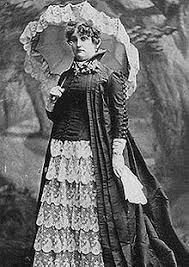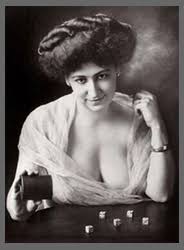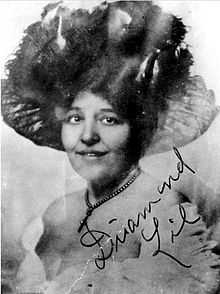1843 – Charles Dickens’ “A Christmas Carol” was first published in England.
A Sporting Woman in Dawson City

In 1898, Dawson City in the Yukon Territory was the heart of the richest gold country on the continent. To its theaters and dance halls the miners came for relief from the long, lonely hours spent working on their claims. They laughed, drank, and threw their gold dust recklessly about. The amenities offered in Dawson City were few, but basic: drink, a woman, and a place to unload his gold dust. Every other building carried the sign, “Gold Dust Bought,” while the rest catered to his sensual needs.
Mattie Silks, the notorious Denver courtesan, was on board the Susie on the last down-river trip of the 1898 season. She was leaving Dawson because her gambler-lover, Cortez Thompson, could not stand the bitter rain and snot of the Klondike. Mattie and Cortez had come to Dawson City figuring that the special merchandise Mattie offered was in far greater demand in the northern reaches than in Denver. The Dawson City Mattie found looked much the same as the towns of the American prairie and Rockies. Built on a flat in a bend of the river, Dawson was a collection of hastily erected log and frame shanties, a little larger than its neighbor, Lousetown.
Jenkins, proprietor of the Sour Dough saloon, rented Mattie a good-sized frame building on Second Street for $350.00 a month. Her leading competitor was Beatrice Larne. Mattie’s expenses were high, but her total receipts were enormous. Each of her girls was earning about fifty dollars a day, even after paying Mattie her fifty per cent of the take plus board. Mattie’s sales of liquid refreshments brought huge profits, for she sold champagne for thirty dollars a quart with the boarder’s cut on each being only five dollars. Whiskey was fifty cents a shot, but there was no beer or gin in Dawson. Most of the whiskey was made from grain alcohol which cost sixty dollars a gallon; when diluted and colored and sold by the drink, the gallon brought in over $130.
Mattie brought along the old gold scales she once used at Georgetown and a little square of thick carpet to catch the dust which spilled from the scales. As usual, Cortez was no help with the business, because he spent most of his time playing faro at Joe Cooper’s Dominion Saloon. Late in the summer, Cortez developed a heavy cold and treated it with his favorite remedy, whiskey. Mattie, too, couldn’t stand the constant downpour which left Dawson’s streets ankle-deep in mud. All around her, Mattie saw evidence of colds which developed into pneumonia, and she dreaded the approach of the long Artic winter. She wanted to go home to Denver, so she squared up Cortez’s gambling debts and booked passage on the Susie, taking back a net profit of $38,000 for her ninety days at Dawson City.
To learn more about Mattie Silks and other sporting women in the
Old West read Wicked Women.
This Day…
Big Alice Shot by Bessie Colvin

It wasn’t uncommon in the Old West for sporting women to fight with one another over territory or money. In El Paso, Texas, competition was especially keen between two popular madams, Big Adam Abbott and quick-tempered Etta Clark across the street. The continuous argument finally erupted in a fight, the mention of which brought uproarious guffaws in the saloons for months to come. Around 9:30 on the warm spring evening of April 18, 1886, a police squad was sent to investigate a disturbance at one of the houses on Utah Street. The whole area was in an uproar as a huge woman lay shot and bleeding in the dusty street, while a petite redhead, cruelly beaten, sobbed hysterically in one of the houses.
The officers somehow pieced together the story. Bessie Colvin, one of Big Alice’s in-residence girls, owed her $125 “back rent,” but refused to pay up. Bessie, full of whiskey and false courage, stood firm as she and Alice put on a screaming and cursing match which awed all passersby. Bessie flounced out, dashed across to Etta Clark’s brothel, and offered her services. Redheaded Etta promptly accepted, so Bessie tore back to her former home, told Big Alice she was leaving, then promptly took off again. Big Alice, with her girls Nina Ferrall and Josie Connaly at her heels, huffed and puffed across the street. Alice yelled and pounded on Etta’s door until it was opened a crack. Big Alice flung herself against the door, ripping it from the hinges and mashing Etta’s face in the process. At this moment, Alice spied her former girl walking out of Etta’s sitting room.
Enraged, Alice stomped on through the broken door, shoving Etta violently aside. The redheaded Etta, deciding she needed protection, reached for a brass gas-lighter. (This was a heavy wick-tipped rod 2 ½ feet long and ½ inch in diameter, used to light the gas burners.) The tiny Etta drew herself up and shook the lighter in Big Alice’s face. Bessie was whimpering in the corner. Now Alice, blind with anger, raised her huge fist and hit Etta in the face as hard as she could. Bessie ran to help Etta, but was grabbed by Alice, who ran out the door, pulling Bessie along with her.
Etta ran to her room and came back with a Colt .45 in her hand. She pointed the weapon at Big Alice, who was facing her on the porch. The gun went off, enveloping both women in a cloud of smoke. Alice looked down in horror at the blood spreading from a spot between her thighs. She staggered to the center of the street as Etta fired again and missed.
It took six strong men to carry the big woman to her house. It made a dramatic scene: the helpless female, the girls weeping and wailing, and the men straining and stumbling under their mammoth burden. Doctor A. L. Justice was called and, upon arriving at the scene, reported that Big Alice was seriously wounded. Etta Clark was put in jail pending a hearing.
By April 27, nine days later, Big Alice was out of danger and the preliminary trial was held in her room. Justice L. H. Clark bound Etta over to the Grand Jury under $2,000 bond.
Nothing funny about this, you say? True enough-but it was the aftermath of this unfortunate incident that sent El Paso rocking with laughter. The Herald’s story was printed under a banner headline with all the details in typically turgid prose. The reporter, trying to be precise in pinpointing Alice’s wound, wrote that Big Alice had been shot in the “public” arch. In Alice’s case, this anatomical description was precise, indeed.
To learn more about soiled doves of the Old West read Wicked Women.
This Day…
Madame Moustache
Enter to win a copy of any book in the catalog of books written
by Chris Enss when you play Snowman Hunt on this very website.

One of the many fabulous and colorful characters of the California gold rush was Eleanore Dumont, known as Madam Moustache, who made her headquarters in Nevada City, California, for a while. According to the legend, Eleanore was a beautiful French woman who bore a slight growth of fuzz over her upper lip. One evening, a tired and thoroughly drunk miner made the trip to town to see the much-talked-of beauty. He took a look and yelled, “She’s pretty, for sure, but look at her moustache.” From that time on, Eleanore Dumont was laughingly called Madam Moustache.
The Nevada City establishment of Madam Moustache was a bit plusher than the average gold-camp bar. It contained a long, rough-boarded room which was fully fifty feet in length. The walls were draped with colored cloth and imported from France. The Madam boasted the fanciest bar in California, behind which the gin slingers served fifty men at a time. At one end of the room was a cleared space for dancing and an orchestra of fifteen pieces. The rest of the space was taken up by twelve or more tables for poker, twenty-one, or monte.
When Nevada City’s boom collapsed, so did Madam Moustache’s parlor house. Eleanore began moving from one camp to another, her fortunes gradually declining. Her beauty faded, she drank too much, and a darker shadow of down was growing on her upper lip. The Madam’s gaming skills began slipping too – ever so slightly, but an extra drink or two can make all the difference at cards. In 1859, with the discovery of the rich diggings of Nevada’s Comstock Lode, she joined the Washoe rush. By 1860, it was common knowledge the Madam was no longer deigned to make money other than at the vingt-et-un table.
Eleanore roamed across the West, following the new mining camps to Idaho and then the Black Hills. As her fortunes continued to plummet, she resumed the sale of her own flesh, offering her services in the construction camps along the route of the Union Pacific Railroad. In 1877, Madam Moustache was running a small-time brothel in Eureka, Nevada; two years later, the Sacramento Union of September 9, 1879, ran a brief dispatch from Bodie, California: “A woman named Eleanore Dumont was found dead today about one mile out of town, having committed suicide.”
To learn more about Eleanore Dumont and other soiled doves just like her enter to win a copy of the book Wicked Women.
Play Snowman Hunt here on this very site and enter to win!
This Day…
Diamond Tooth Lil
Enter to win a copy of a book from the catalog of titles penned
by Chris Enss.
Find the snowmen and be a winner.

The soiled dove with the heart of gold is a stock character in thousands of stories about the Old West, and Idaho had such a character. “Diamond-tooth Lil” was her name, and she was more famous for her tooth of gold than for her heart of gold. Like most characters in western lore, Lil devoted her lifetime to perfecting her own legend and image. Her gold tooth, prominent in the middle of her smile, was set with a large diamond to gain Lil instant recognition in any company. And Lil loved it. From childhood she had thirsted for fame.
All we know about Lil’s colorful life comes from her own stories, recounted through the years to just about anyone who would listen. Whether her stories were true or not does not seem too important, for they make good telling. Mae West’s characterization of “Diamond Lil” was based on the life of Idaho’s Lil, and in all accounts of her life, the stress lay on Diamond-tooth Lil’s beauty and glamor. Words like “fabulous and exciting” are regularly used to describe her, although it was not Lil’s looks but her vitality and sense of showmanship which evoked such adjectives.
Evelyn Hildegarde was born Katie Prado near Vienna, Austrian, about 1880. It appears that she and her parents-an Austrian father and a Bohemian mother-came to America when Katie was six-years-old. When Katie ran away from home, she was only thirteen, but she was quite mature for her age and looked sixteen. She had eloped with nineteen-year-old Percy Hildegarde and used his last name the rest of her life.
By her own account, Lil had a total of eight husbands, never worrying about ridding herself of a husband, but just taking another when the mood struck her.
Among the men in her life were some pretty colorful characters: prizefighter Kid McCoy, Spider Kelly, Diamond-field Jack Davis, Tex Rickard, and Tom Sharkey. Diamond-tooth Lil’s friendship with Diamond-field Jack was a natural. The swaggering Jack had plenty of color all his own; although notorious as a gunman, his chief claim to fame was that he was almost hung for a murder he did not commit. Perhaps Jack was the inspiration for Lil’s famous tooth, for she did not have one when they met in 1907 in the boomtown of Goldenfield, Nevada.
Lil had been singing and dancing in music halls and gambling palaces for several years before she ran up against Jack. She was the “toast of the Barbary Coast,” and a star at the St. Louis World’s Fair in 1904, singing at the Anheuser-Busch Pavilion. But somewhere along the way she got in on the gold rush to Alaska, then came back south to Silver City, Idaho. Boise was her home from 1909 until 1943, during which time she ran rooming houses and opened the Depot Inn in 1933. Diamond-tooth Lil’s experience as a “business woman” began years before, for she claimed she was a madam from the time she was thirteen, and ran large houses in Chicago, St. Louis, New York, and Seattle.
One of her “’bosses” in Chicago was said to be Al Capone, and it is no surprise that Lil was not repelled by the violence of the gangster era. Lil herself had had a taste of violence years before, when she was shot at by an ex-husband in El Paso, Texas. Charitable and generous, Lil felt a special sympathy for orphans, and when she left Boise for the warmer climate of California, she promised to will her famous tooth to the Boise Children’s Home. But she died in California in 1967 at age eighty-nine, and the tooth which made her famous, was buried with her.
For more information about Diamond Lil read
Wicked Women: Notorious, Michievous, and Wayward Ladies
from the Old West.
The Girls of the Line
Enter to win a Christmas giveaway.
Find the hidden snowmen on the website and enter to win a copy of any of the books in the catalog of books penned by Chris Enss.

For many years, the town of Pueblo, Colorado, boasted one of the most wide-open tenderloin districts of the West. The townspeople gave tacit if not explicit consent to the thriving business in flesh all the way into the twentieth century, until the bawds left their district to parade downtown on April 18, 1903. The invasion of sinners was described on page one of the Pueblo Star-Journal the next day:
“Shamelessness Runs Riot Without Interference of Police”
Dissolute women raided the sidewalks of Santa Fe Avenue between First and Fourth Streets last evening and accosted passersby without let or hinderance from the police. No less than four complaints were made to the Star-Journal by Santa Fe Avenue businessmen who protested the conditions were such that reputable people were being driven away from the neighborhood. Investigations showed that the complaints were to be well grounded and the state of things prevail such as would not be tolerated in any city where the police department was required by order from the executive, from whom it must come, to enforce even a reasonable degree of decency. Well-known businessmen informed the Star-Journal not only last night, but other nights, they have made specific complaints at police headquarters without result and without securing other reply than a mocking laugh. The Star-Journal does not propose that such things shall continue and it now directs the personal attention of the Mayor to the matter and demands that he compel suppression of the evil.
The girls worked either as individuals or in small groups, perhaps in the house of a madam. Such a house was often lavishly furnished and decorated, and generally conducted business with more select clientele. At the other extreme, in the crib, a girl working on her own plied the same trade in conditions ranging from sparseness to squalor. These cribs would be strung in a line along one street, thus giving the prostitution district the popular name “the line.” It was also known as the red-light district after the red lights posted in the windows all along the line.
Myers Avenue, the line in Cripple Creek, Colorado, was lifted into national prominence after Julian Street, a famed writer of the day, took a horrified look at it and wrote an uncomplimentary article in Collier’s. The town leaders were so incensed they bombarded the magazine’s editors with telegrams. When these left the editors unmoved, the council sent out the following news bulletin: “Tonight the city council of Cripple Creek, Colorado, approved unanimously changing the name of Myers Avenue to Julian Street.” And Julian Street it is still called.

